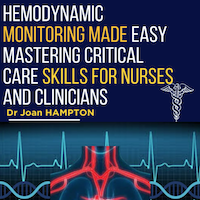Tag: vasopressors
Prevalence and Outcomes of Shock in Internal Medicine Patients
This retrospective observational study investigated the incidence, management, and outcomes of 125 shock patients admitted to the internal medicine department of a referral university hospital in Bangkok, Thailand, addressing... read more
Severe Listeriosis in the ICU: Critical Insights from a Multicenter Study
A retrospective multicenter study across 23 French hospitals over 10 years analyzed critically ill ICU patients with culture-confirmed "Listeria monocytogenes" infections. The study aimed to describe patient characteristics,... read more
Seraph-100 Hemoperfusion: Clearing Pathogens and Enhancing Outcomes in Sepsis
This study evaluated Seraph-100 hemoperfusion (HP) as a treatment for sepsis in intensive care unit (ICU) patients admitted after cardiac surgery for infective endocarditis (IE). Thirteen septic patients received Seraph-100... read more
Push-Dose Epinephrine Use in the Emergency Department
A retrospective multi-site cohort study investigated the use of push-dose epinephrine (PDE) in emergency departments (EDs) for managing hypotension in critically ill patients. Recognizing the limited ED-specific data compared... read more
Hemodynamic Stabilization Using CRRT and cIVNa Combination Therapy
Compared with conventional continuous renal replacement therapy (CRRT), combination therapy of CRRT and continuous intravenous sodium infusion therapy (cIVNa) increased blood pressure, enhanced urinary volume, and reduced... read more
Early Initiated Noradrenaline vs. Fluid Therapy for Hypotension and Shock
The VASOSHOCK trial is a pragmatic, multi-center, superiority, randomized controlled trial investigating early initiation of peripheral noradrenaline in hypotension and shock, investigating the impact of this treatment on... read more
Septic Distributive Shock: Resuscitative Endovascular Balloon Occlusion of the Aorta
Massive distributive shock can lead to total collapse of the cardiopulmonary system with a subsequent need for CPR. Partial REBOA may be a viable resuscitation adjunct in such cases to restore hemodynamics and increase coronary... read more
Lactate Trajectory Models for Predicting AKI and Mortality in Hyperlactatemia Patients
The present study underscores the significant prognostic value of lactate trajectories in critically ill patients, particularly those with hyperlactatemia. Our findings suggest that rapid lactate clearance is strongly... read more
Hemophagocytic Lymphohistiocytosis Markers Associated with Mortality in Critically Ill Patients
The present study highlights the prognostic significance of HLH criteria in critically ill patients. Individuals exhibiting two or more criteria at ICU admission experienced nearly a doubling in mortality as compared to patients... read more
Clinical Prediction Model Development for Stages of AKI in Critically Ill Patients
Using readily available predictors in the ICU setting, we could develop a prediction model for different stages of AKI with good performance and promising clinical usefulness. Among critically ill patients, acute kidney... read more
Total Bilirubin as a Marker for Hemolysis and Outcome in ARDS Patients Treated with vvECMO
Patients with acute respiratory distress syndrome (ARDS), treatment with veno-venous ECMO and a total bilirubin (tBili) plasma concentration over the threshold of 3.6 mg/dl had significantly lower chances of survival, recovery... read more
The Vasopressor & Inotrope Handbook: A Practical Guide for Healthcare Professionals
An indispensable resource for physicians, nurse practitioners, physician assistants, pharmacists, and nurses in managing critically ill patients. This comprehensive guide delves deep into the world of vasopressors and inotropes,... read more

Vasoactive Agents in Cardiogenic Shock Related to AMI and ADHF
Cardiogenic shock (CS) is a heterogeneous condition associated with exceptionally high mortality rates, despite significant advances in the field of cardiology. The primary causes of CS are myocardial infarction-related CS... read more
Methylprednisolone vs. Hydrocortisone in Septic Shock Patients
Corticosteroids play an important role in the management of septic shock patients, especially in those with higher doses of vasopressor. However, the therapeutic benefits of corticosteroids are not limited to hydrocortisone... read more
Machine Learning Model for Predicting Acute Pancreatitis Mortality in the ICU
Machine learning model has been proved to be superior to existing prediction scores for mortality prediction of Acute Pancreatitis (AP). The use of most of previous ML models is limited in clinical practice, mainly due... read more
Impact of Short-Acting Beta-Blockers on the Outcomes of Septic Shock Patients
In patients with septic shock, short-acting beta-blockers may improve survival and reduce new-onset tachyarrhythmias. However, these findings were based on low certainty evidence and given ongoing concerns regarding adverse... read more
Predicting MODS in Trauma-induced Sepsis with Machine Learning Models
The nomogram and machine learning models provide enhanced predictive accuracy for multiple organ dysfunction syndrome (MODS) in trauma-induced sepsis patients compared to traditional scoring systems. These tools, accessible... read more
Code Sepsis – Early Decompensation and Predictors
Early recognition and management of sepsis within the first hour of a sepsis alert is critical for patient survival, requiring healthcare providers to be trained to identify "red flag" symptoms like rapid breathing (tachypnea)... read more
Hemodynamic Monitoring Made Easy: Mastering Critical Care Skills for Nurses and Clinicians
This thorough, simple-to-follow book was created especially for critical care nurses, clinicians, and other healthcare workers to help you fully utilize hemodynamic monitoring. With its straightforward, methodical approach... read more

Clinical Outcomes of Early Phenotype-Desirable Antimicrobial Therapy for Enterobacterales Bacteremia
This is first study to compare clinical outcomes between patients with E coli, K pneumoniae, K oxytoca, and P mirabilis BSIs receiving early PDAT vs delayed PDAT using DOOR analysis. Receiving early phenotype-desirable... read more
IFG vs. CBG in Patients with Multiple Organ Failure Requiring Vasopressor Infusion
Interstitial flash glucose (IFG) does not demonstrate either analytical or clinical accuracy to be considered equivalent to capillary blood glucose (CBG) in patients with multiple organ failure who require vasopressor infusion. This... read more
Prediction of AKI in ICU Patients Based on Interpretable Machine Learning
The machine learning model described in this study is capable of accurately predicting the onset of AKI in ICU patients up to 24 hours in advance. Validated within the MIMIC-IV and MIMIC-III databases, the model demonstrates... read more









